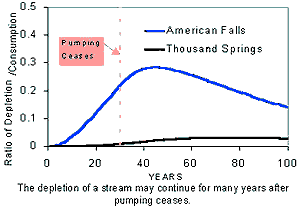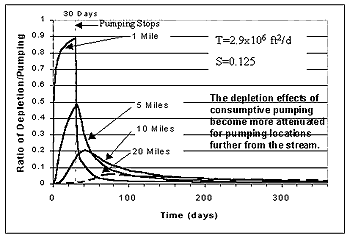What Controls
the Degree of Surface and Ground Water Interaction?
 An
analogy is often made between an overflowing horse trough and an aquifer.
The horse
trough has a continual source of water flowing in at a fixed rate. Obviously,
the trough must also have an overflow that is flowing at the same rate.
If a small pump is introduced into the trough and begins pumping continuously,
then the overflow will soon be depleted by an amount equal to the rate of pumping.
In many ground water systems, surface water supplies are ultimately depleted by
an amount of water equal to volumes pumped and consumptively used. The effects
of pumping on surface water sources are normally greatly attenuated relative to
the horse trough analogy. The effects of pumping on surface water supplies
may be distributed over years, or even decades, depending on the size and properties
of the aquifer. Johnson and others (1993) demonstrates how the stream depletion
effects for 30 years of continuous pumping from the Snake River Plain aquifer
persist for decades after pumping ceases (see graph right).
An
analogy is often made between an overflowing horse trough and an aquifer.
The horse
trough has a continual source of water flowing in at a fixed rate. Obviously,
the trough must also have an overflow that is flowing at the same rate.
If a small pump is introduced into the trough and begins pumping continuously,
then the overflow will soon be depleted by an amount equal to the rate of pumping.
In many ground water systems, surface water supplies are ultimately depleted by
an amount of water equal to volumes pumped and consumptively used. The effects
of pumping on surface water sources are normally greatly attenuated relative to
the horse trough analogy. The effects of pumping on surface water supplies
may be distributed over years, or even decades, depending on the size and properties
of the aquifer. Johnson and others (1993) demonstrates how the stream depletion
effects for 30 years of continuous pumping from the Snake River Plain aquifer
persist for decades after pumping ceases (see graph right).
Difficulties arise in determining
the timing, location, and magnitude of the impacts. The degree to
which ground water pumping depletes surface water supplies is dependent on several
features of the particular basin. Considerations include: 1) the degree
to which the river and aquifer are interconnected, 2) the distance between the
river and the pumping source, 3) the rate of pumping, and 4) the physical characteristics
of the aquifer. These factors are discussed in the following paragraphs.
The degree of river and
aquifer interconnection is of great importance in controlling the amount of
surface water depletion resulting from ground water pumping. If a river
is perched above an aquifer, ground water pumping has no effect on river flow.
If the river is not perched, but sediments have accumulated in the riverbed,
or the river only slightly penetrates into the aquifer, then the hydraulic communication
between the river and aquifer may be limited. Examples are shown
in the following illustrations: partially
penetrating river with silt deposition and fully
penetrating rivers. Spring discharge will nearly always be impacted
by nearby ground water pumping from the same aquifer.
 The distance between a surface water body and a pumping location strongly affects
the timing and degree that pumping will impact stream depletion. Pumping
near an interconnected surface water body will have a nearly immediate impact
on the surface water source. The impact may be nearly equal to the rate
of ground water pumping. At greater distances, the effects of pumping
will be distributed over longer time periods and may be shared with other hydraulically
connected surface water bodies.
The distance between a surface water body and a pumping location strongly affects
the timing and degree that pumping will impact stream depletion. Pumping
near an interconnected surface water body will have a nearly immediate impact
on the surface water source. The impact may be nearly equal to the rate
of ground water pumping. At greater distances, the effects of pumping
will be distributed over longer time periods and may be shared with other hydraulically
connected surface water bodies.
The rate of stream depletion
associated with pumping from a given location is normally proportional to the
rate of ground water pumping. If the rate of pumping from a given well
is doubled, then the rate of stream depletion resulting from pumping that well
also doubles. Stream depletion will be proportional to pumping rate unless aquifer
water levels change so dramatically that springs are dried up, streams become
perched, or aquifer properties change.
Ground water that is pumped,
but not consumptively used (for example, industrial pumping that is discharged
to seepage ponds), may return to the aquifer from which it was extracted and
have little or no impact on surface or ground water supplies outside the immediate
vicinity. Similarly, ground water pumped in excess of the amount required
for crops to grow may return to the aquifer and have little or no quantitative
impact on the surrounding resource. It is the amount of water that is
permanently extracted from the aquifer and consumptively used that is of significance.
 Aquifer physical characteristics also affect the timing and magnitude of stream
depletion from pumping. Aquifer layering, water transmission, and storage
properties may have a strong influence on the direction and rate of propagation
of pumping effects. Wells completed in deeper layers may have a more disbursed
and delayed impact on surface water bodies than wells completed in upper layers
of an aquifer. Highly transmissive aquifers with limited water storage
capacity will transmit effects more rapidly than aquifers of lower permeability
or higher storage capacity.
Aquifer physical characteristics also affect the timing and magnitude of stream
depletion from pumping. Aquifer layering, water transmission, and storage
properties may have a strong influence on the direction and rate of propagation
of pumping effects. Wells completed in deeper layers may have a more disbursed
and delayed impact on surface water bodies than wells completed in upper layers
of an aquifer. Highly transmissive aquifers with limited water storage
capacity will transmit effects more rapidly than aquifers of lower permeability
or higher storage capacity.
A common misconception
is that impacts of ground water pumping may be projected along estimated flow
paths through an aquifer. If this were true, then only down-gradient streams
and springs would be affected by up-gradient pumping. In fact, the effects
of ground water pumping propagate radially in all directions (assuming aquifer
properties are uniform), regardless of the direction of ground water flow.
This means that pumping effects are felt upstream, laterally across the gradient,
and downstream, making conjunctive water rights allocation extremely difficult.
In the case of the Snake River Plain aqufier, this means that even down-gradient
pumpers have some impact on the upper river reaches.
Snake River Reach maps, which demonstrate the effects of long-term pumping
on various reaches of the Snake River, are presented for example.
Information supplied by Idaho
Water Resource Research Institute, University of Idaho December 1998
Authors: Dr. Gary Johnson, Donna Cosgrove, and Mark Lovell.
Graphics: Sherry Laney and Mark Lovell of Idaho Water Resources Research Institute.
All State of Idaho images and graphics created with GIS files obtained through
Idaho Department of Water Resources Public Domain GIS unless otherwise noted.
Source
Information
 The distance between a surface water body and a pumping location strongly affects
the timing and degree that pumping will impact stream depletion. Pumping
near an interconnected surface water body will have a nearly immediate impact
on the surface water source. The impact may be nearly equal to the rate
of ground water pumping. At greater distances, the effects of pumping
will be distributed over longer time periods and may be shared with other hydraulically
connected surface water bodies.
The distance between a surface water body and a pumping location strongly affects
the timing and degree that pumping will impact stream depletion. Pumping
near an interconnected surface water body will have a nearly immediate impact
on the surface water source. The impact may be nearly equal to the rate
of ground water pumping. At greater distances, the effects of pumping
will be distributed over longer time periods and may be shared with other hydraulically
connected surface water bodies.
 An
analogy is often made between an overflowing horse trough and an aquifer.
The horse
trough has a continual source of water flowing in at a fixed rate. Obviously,
the trough must also have an overflow that is flowing at the same rate.
If a small pump is introduced into the trough and begins pumping continuously,
then the overflow will soon be depleted by an amount equal to the rate of pumping.
In many ground water systems, surface water supplies are ultimately depleted by
an amount of water equal to volumes pumped and consumptively used. The effects
of pumping on surface water sources are normally greatly attenuated relative to
the horse trough analogy. The effects of pumping on surface water supplies
may be distributed over years, or even decades, depending on the size and properties
of the aquifer. Johnson and others (1993) demonstrates how the stream depletion
effects for 30 years of continuous pumping from the Snake River Plain aquifer
persist for decades after pumping ceases (see graph right).
An
analogy is often made between an overflowing horse trough and an aquifer.
The horse
trough has a continual source of water flowing in at a fixed rate. Obviously,
the trough must also have an overflow that is flowing at the same rate.
If a small pump is introduced into the trough and begins pumping continuously,
then the overflow will soon be depleted by an amount equal to the rate of pumping.
In many ground water systems, surface water supplies are ultimately depleted by
an amount of water equal to volumes pumped and consumptively used. The effects
of pumping on surface water sources are normally greatly attenuated relative to
the horse trough analogy. The effects of pumping on surface water supplies
may be distributed over years, or even decades, depending on the size and properties
of the aquifer. Johnson and others (1993) demonstrates how the stream depletion
effects for 30 years of continuous pumping from the Snake River Plain aquifer
persist for decades after pumping ceases (see graph right).
 Aquifer physical characteristics also affect the timing and magnitude of stream
depletion from pumping. Aquifer layering, water transmission, and storage
properties may have a strong influence on the direction and rate of propagation
of pumping effects. Wells completed in deeper layers may have a more disbursed
and delayed impact on surface water bodies than wells completed in upper layers
of an aquifer. Highly transmissive aquifers with limited water storage
capacity will transmit effects more rapidly than aquifers of lower permeability
or higher storage capacity.
Aquifer physical characteristics also affect the timing and magnitude of stream
depletion from pumping. Aquifer layering, water transmission, and storage
properties may have a strong influence on the direction and rate of propagation
of pumping effects. Wells completed in deeper layers may have a more disbursed
and delayed impact on surface water bodies than wells completed in upper layers
of an aquifer. Highly transmissive aquifers with limited water storage
capacity will transmit effects more rapidly than aquifers of lower permeability
or higher storage capacity.